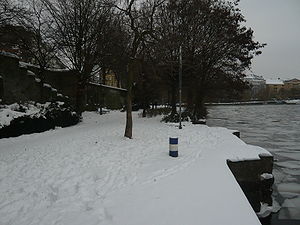Borsigsteg
Coordinates: 52 ° 31 ′ 15 ″ N , 13 ° 20 ′ 20 ″ E
| Borsigsteg | ||
|---|---|---|
| Riverside path on the bank of the Bundesrat with the remains of the Borsigsteg, January 2010 | ||
| use | pedestrian | |
| Crossing of | Spree | |
| place | Moabit | |
| construction | Iron truss suspension bridge | |
| width | around 5 m | |
| Longest span | 24.00 m | |
| start of building | 1904 | |
| completion | 1906 | |
| closure | Destruction in April 1945 | |
| location | ||
|
|
||
The Borsigsteg was a pedestrian bridge at about 11.80 km of the Spree and connected Dortmunder Strasse in the Berlin district of Moabit with Flensburger Strasse in the Hansaviertel district . The building was built between 1904 and 1906 according to plans by Bruno Möhring and Friedrich Krause . The jetty was destroyed by members of the German armed forces at the end of the Second World War .
Establishment
Due to the rapid growth of the Borsig works in the Moabit area in the middle of the 19th century and the emergence of residential areas for the numerous working-class families, a short connection across the Spree became necessary. The architect Bruno Möhring and the civil engineer Friedrich Krause, who had already successfully worked together on the construction of the Swinemünde Bridge , provided construction plans for a pedestrian bridge at the beginning of the 20th century. The Ernst Wasmuth Verlag published the draft in its architecture magazines. The plans envisaged an iron truss girder bridge as a suspension structure with monumental stone portals above the pylons . Cast iron lanterns and candelabra in Art Nouveau style formed the further bridge decoration of this Spree crossing, built only for pedestrians, between the Schleswig shore and the bank of the Bundesrat. When the bridge was opened, it was named Borsigbrücke in honor of the factory owner August Borsig , who had made a major contribution to the growth of this part of Berlin.
destruction
Already in 1915 this bridge was destroyed, as a literature reference shows. However, it can be assumed that a repair was carried out, because the standard book Berlin and its bridges describes the destruction at the end of the Second World War. The Nero order of the German Wehrmacht had also led to the demolition of this historic building. In another source, a contemporary witness reports on the destroyed Borsigsteg in 1947. The water obstacle was then removed, but the remains of the bridge's abutments have been preserved on both banks. Reconstruction plans are not known.
In the neighborhood
At the corner of Dortmunder and Bochumer Strasse on the banks of the Bundesrat there is a small neighborhood restaurant called Zum alten Borsigsteg , which is reminiscent of the long-destroyed bridge structure. However, the restaurant has been closed since the 2000s.
The modern development of the Spreebogen on the northwestern bank of the Spree dominates the appearance around the former location of the Borsigsteg. Two buildings on the banks of the Bundesrat (number 2, “Haus Lessing” and number 10, a tenement house) from the initial construction period have been renovated and are under monument protection . The former secondary school building, which is now used by the Tiergarten Gymnasium, has been preserved on the Schleswiger Ufer (picture).
literature
- Landesdenkmalamt Berlin (ed.), Jürgen Tomisch, Matthias Donath, Angelika Kaltenbach, Klaus von Krosigk, Heino Neumayer, Gabriele Schulz: Monument topography of the Federal Republic of Germany. Monuments in Berlin - Mitte district - Moabit, Hansaviertel and Tiergarten districts. Michael Imhof Verlag, Petersberg 2005, ISBN 3-86568-035-6 .
- Eckhard Thiemann, Dieter Deszyk, Horstpeter Metzing: Berlin and its bridges. Jaron Verlag, Berlin 2003, ISBN 3-89773-073-1 , p. 180.
- Klaus-Dieter Wille: Walks in the Tiergarten. Haude & Spenersche Verlagbuchhandlung, Berlin 1982.
- Borsigsteg. In: Wasmuthsmonthshefte. 1920, Berlin, p. 294.
Web links
Individual evidence
- ↑ 6 pages with old illustrations and explanations about the Borsigsteg. (PDF; 12.1 MB) University of Stuttgart
- ^ Bertram Janiszewski: The old Hansa district in Berlin. Shape and people. P. 93; Retrieved November 12, 2009
- ↑ Hans Aschenbrenner: Where the Borsigmühle once stood . In: Berlin monthly magazine ( Luisenstädtischer Bildungsverein ) . Issue 1, 1998, ISSN 0944-5560 , p. 97-100 ( luise-berlin.de ).
- ↑ Dietmar Arnold, Reiner Janick, Ingmar Arnold, Gudrun Neumann: Sirens and packed suitcases: everyday bunker life in Berlin. Ch. Links Verlag, Berlin 2003, ISBN 3-86153-308-1 , p. 146.
- ↑ Haus Lessing monument , built 1912–1913 by Georg Jacobowitz
- ↑ Architectural monument tenement, built by Paul Schöne in 1906–1907



